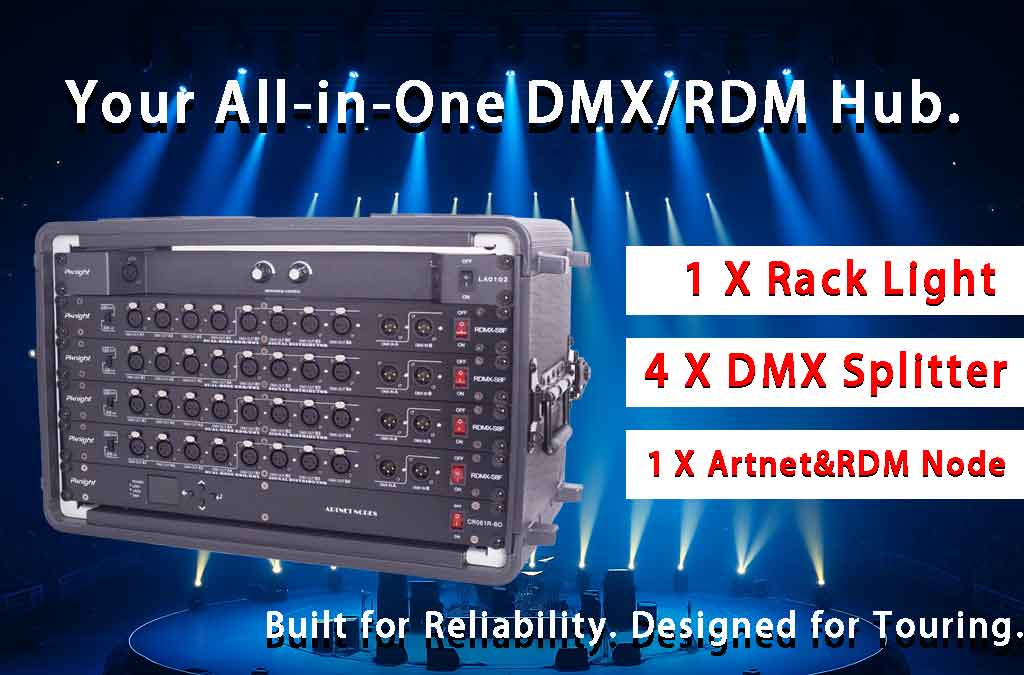
An integrated Art‑Net‑to‑DMX hub for touring, venues, and rental houses—built to be specified once and deployed everywhere.
Why this exists
Large shows still fight the same battles: long cable runs, crowded racks, last‑minute fixture changes, and “which splitter feeds which truss?” confusion. Off‑the‑shelf nodes, splitters, and random flight cases do work—but they multiply patch points and failure modes.
Pknight’s customizable rack‑mount distribution system puts the whole signal path in one flight‑ready case: Art‑Net in → up to 8 universes of DMX out, routed through opto‑isolated splitters with RDM, labeled and wired exactly the way your crew patches a rig. Buy it once, roll it in, power up, and start focusing.

At a glance

- Protocol: Art‑Net (sACN not supported in this version)
- Capacity: Up to 8 universes per box
- Distribution: Modular 1→8 DMX splitters with RDM
- Dual‑Mode Splitters (A/B): Each splitter can run single‑universe (one input fan‑out) or dual‑universe (A/B) mode—so a single module can accept two universes when you need it
- Connectors: 3‑pin, 5‑pin, or mixed—factory‑built to your spec
- Electrical design: Full optical isolation on outputs, independent power per splitter row
- Power: 100–240 V AC wide‑range input (global touring ready)
- Enclosure: Shock‑resistant flight case with rack‑mount front, fast latches, side handles, and front‑panel brightness control
- Branding & layout: OEM/ODM supported—panel labeling, port layout, and connector mix are customizable
What’s inside the case
-
Art‑Net Node (up to 8 universes)
Converts your network from FOH into DMX. Front‑panel indicators (Power/Link/DMX) make line checks quick and obvious. -
RDM‑capable DMX Splitters
True 1→8 distribution with full opto‑isolation for noise immunity and fault containment. The “dual‑mode” design accepts one universe or two universes (A/B), so you can feed two zones from the same module when it simplifies patching. -
Touring‑grade mechanics
Road case shell, recessed hardware, and a clean front to keep labeling readable in the dark. A brightness knob prevents blinding LEDs on a dark stage.
How the A/B “dual‑mode” splitters help

There are days when one input fanning out to eight outputs is perfect. There are other days when you want two separate universes to travel down the same line of stage boxes and split left/right or ground/truss.
Our splitter modules support both patterns:
- Single‑Universe Mode – one DMX input → eight isolated outputs (typical “1→8” use).
- Dual‑Universe Mode (A/B) – two DMX inputs presented to the module; outputs are clearly labeled A or B so your team instantly knows which universe feeds which port.
- RDM‑ready by design – keep remote discovery and addressing in your toolkit without cobbling together extra hardware.
Result: fewer boxes to carry, fewer mistakes to make, and a patch sheet that actually matches the front panel.
Typical deployments
- Arena/Concert: FOH console → network switch → Pknight case at dimmer world → A/B splitters feed stage‑left and stage‑right trusses; floor packages get their own universe groups.
- Touring theatre: Pre‑labeled outputs per act/scene—swap venues, keep the same box, keep the same workflow.
- Rental house standard kit: One part number you can prep fast and explain faster to freelancers.
Why an integrated system beats a patchwork
- Fewer interconnects, fewer failures. One enclosure = fewer loose IECs, wall‑warts, and flying splitters.
- Predictable grounding & isolation. Full opto‑isolation on every output reduces ground loops and protects the rig.
- Repeatable labeling. Universes, zones, and outputs are silkscreened exactly the way your crew thinks.
- Better value as a bundle. Buying a factory‑built system is often cheaper than assembling comparable gear piece‑by‑piece—and it arrives ready to roll.
Configuration & ordering guide
Choose the options that fit your show—or ask us to clone your house style:
- Universe count: 1 to 8 Art‑Net universes per box
- Splitter population: Number of 1→8 modules and whether you prefer single‑universe or A/B routing on each
- Connector mix: 3‑pin, 5‑pin, or mixed per row
- Front‑panel layout & labels: Your universe names, zone names, logo, and color coding
- Rack height & case options: We’ll build to your space and weight targets
Power draw and thermal figures are available on request; in practice they are modest for this class of gear.
Specifications (summary)
- Input protocol: Art‑Net over Ethernet (sACN not supported)
- DMX universes: up to 8 per enclosure
- Distribution modules: 1→8 DMX, RDM‑capable, A/B dual‑mode (one or two universes per module)
- Output isolation: Opto‑isolated outputs, independent power per splitter row
- Connector options: XLR 3‑pin, 5‑pin, or mixed
- Mains: 100–240 V AC, 50/60 Hz
- Enclosure: Rack‑mount, flight‑case integrated, serviceable front panel
FAQ
Does it support sACN?
No—this build is Art‑Net only.
How many universes can I run from one case?
Up to 8 universes. The internal splitters can accept two universes (A/B) per module when you want to carry and distribute two separate lines.
Is RDM fully supported?
Yes—the splitters are RDM‑capable so you can discover and configure fixtures over the same infrastructure when your console/workflow uses RDM.
Can I mix 3‑pin and 5‑pin?
Yes. We are the manufacturer—connector type and layout are configurable per row.
What about isolation and safety?
Every output is opto‑isolated. Each splitter row is independently powered for robustness.

